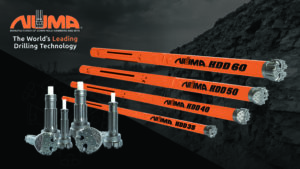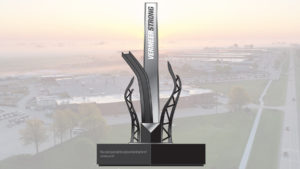Industry News, trenchless people
 Zahra (Ellie) Kohankar Kouchesfehani is a Ph.D. Student and Graduate Research and Teaching Assistant at the Center for Underground Infrastructure Research and Education (CUIRE) in the Department of Civil Engineering at The University of Texas at Arlington. She is a NASTT Student Chapter Member and a valuable volunteer at our annual No-Dig Show.
Zahra (Ellie) Kohankar Kouchesfehani is a Ph.D. Student and Graduate Research and Teaching Assistant at the Center for Underground Infrastructure Research and Education (CUIRE) in the Department of Civil Engineering at The University of Texas at Arlington. She is a NASTT Student Chapter Member and a valuable volunteer at our annual No-Dig Show.
We are excited that Zahra’s submission, “Structural Design Methodology for Spray Applied Pipe Liners in Gravity Storm Water Conveyance Conduits as a Trenchless Renewal Application,” has been selected for an ISTT 2019 No Dig Award.
The selection team found the methodology to be a significant contribution to the trenchless world.
The award will be recognized at the Gala Dinner and Awards Ceremony on October 1, 2019 at the 37th International No Dig Conference in Florence, Italy.
Congratulations, Zahra!
Industry News, trenchless products
Perfect for hard rock and fractured ground formations
 THOMPSON, CONNECTICUT USA, August, 2019:
THOMPSON, CONNECTICUT USA, August, 2019:
Numa, the world’s leading drilling technology provider, has released a range of HDD Drilling Systems designed for productive and efficient drilling in hard rock and fractured ground formations.
“Numa has a long history of serving the HDD market and with our range of HDD Drilling Systems we enhance our ability to serve our customers with the right products for the job,” said Numa President, Ralph Leonard. “Our high quality, Made in the USA HDD products provide the right balance of performance and dependability without sacrificing tool life.”
Numa’s HDD Drilling Systems consist of a variety of HDD components including hammers, bits, side load sonde housings, bent subs, and adaptors which are capable of drilling holes 4″ to 7-1/2″ (102 mm to 191 mm) in diameter. Some of the many benefits Numa touts for the HDD hammer line include: improved steerability, fast penetration rate, simplified field maintenance, reduced air requirements, and lower overall cost per foot.
With deep experience in rock drilling, Numa purposely designed their HDD hammers to drill longer in difficult rock conditions. Furthermore, a single bore design allows for a maximum bore diameter in conjunction with providing optimum life against abrasion. The full line of Numa’s HDD Drilling Systems is made up of the models indicated below with a full description on their website product page.
- HDD 35 for drilling holes 3-7/8” to 4” (98 mm – 102 mm) in diameter
- HDD 40 for drilling holes 4-3/4” to 5” (121 mm – 127 mm) in diameter
- HDD 50 for drilling holes 5-3/4” to 6-1/8” (146 mm – 156 mm) in diameter
- HDD 60 for drilling holes 7″ to 7-1/2″ (178 mm – 191 mm) in diameter
Numa will be featuring their HDD Drilling Systems in booth #1905 at the ICUEE 2019 show happening October 1-3 in Louisville, Kentucky.
ABOUT NUMA
Numa is the world’s leading drilling technology provider, dedicated to ongoing product innovation and results-oriented consistency. We’ve built a strong legacy of high quality, U.S. made hammers and bits for drilling holes 3½ – 50½ inches (89 -1283 mm) in diameter. With over 100 hammer and bit products serving 11 different industries, our products are capable of drilling vertical, horizontal, and reverse circulation holes in hard rock and unconsolidated formations.
Industry News, trenchless people
 Longtime underground construction and trenchless industry professional Davis Yates passed away Tuesday, July 2, 2019 at the age of 51. Through his career Yates worked at trenchless equipment manufacturer TT Technologies, Aurora, Ill., Mocon Corp., Southern California HDPE pipe, fitting and fusion supplier Maskell-Robbins, as well as a variety trenchless and underground contractors along the West Coast.
Longtime underground construction and trenchless industry professional Davis Yates passed away Tuesday, July 2, 2019 at the age of 51. Through his career Yates worked at trenchless equipment manufacturer TT Technologies, Aurora, Ill., Mocon Corp., Southern California HDPE pipe, fitting and fusion supplier Maskell-Robbins, as well as a variety trenchless and underground contractors along the West Coast.
Yates trained many people throughout his career in the proper use of various boring, tools, pipe rammers and pipe bursting systems. He was an energetic and innovative individual whose way of getting the job done was very much appreciated by those he worked with over the years.
Always an innovator, always creative and always seeing the job through, he became great friends with many of the people he worked with in the field and will be missed by many.
Yates leaves behind two children, Jenna, 13 and Marcus, 11. A Go Fund Me page has been established to help with the expenses of his children’s future education, as well as the planting of a remembrance tree. Donations will be placed into a savings plan for both Jenna and Marcus.
The Go Fund Me Page can be found here: https://www.gofundme.com/f/jenna-and-marcus-dad
Industry News, trenchless people
 PELLA, IA – Recently, Vermeer Corporation held the groundbreaking for a monument commemorating the buildings destroyed by an EF3 tornado last July (2018), while celebrating the strength of the Vermeer team and the growth and progress that is happening along the Vermeer Mile.
PELLA, IA – Recently, Vermeer Corporation held the groundbreaking for a monument commemorating the buildings destroyed by an EF3 tornado last July (2018), while celebrating the strength of the Vermeer team and the growth and progress that is happening along the Vermeer Mile.
“The tornado was the greatest challenge Vermeer has ever faced. I am incredibly proud to say our team has turned it into an opportunity. Not only are we rebuilding what we had, but we’re becoming stronger than ever before,” said President and CEO Jason Andringa.
With three new facilities underway at the Pella-based headquarters, Vermeer is investing heavily in the future.
The first facility scheduled to open this summer is a new engineering and R&D building named Shop 48. The name stems from Founder Gary Vermeer’s shop where his innovations came to life and led to the founding of Vermeer Corporation in 1948. With more than 100,000 square feet of space dedicated to building and testing new equipment, team members will begin to move into this space in August.
“We’re very fortunate at Vermeer to have a 71-year history of innovation. Shop 48 will take our innovation and growth opportunities long into the future,” said President of Industrial Solutions Doug Hundt.
Plant 7 was formally announced as the new facility being built where Plants 5 & 6 once stood. Nearly 500,000 square feet of manufacturing and office space will expand beyond the original manufacturing footprint that took up just less than 400,000 square feet of this area. The new facility will connect to the original Plant 7 that was damaged in the tornado but repaired in the months following. Together, they will take on the name Plant 7. Scheduled to be completed in fall 2020, this facility is being built to keep team members safe at every touchpoint on the job, create ultimate productivity, be a collaborative and engaging space for team members and allow for growth long into the future. Incorporating advanced manufacturing techniques and continuous improvement best practices will help drive world-class manufacturing. “Looking ahead, this facility is going to be world-class in every feature. We’re advancing our paint technology, coat technology and the space for our team,” said Vice President of Operations Bill Blackorby.
Also recognized was the new Eco Center. Replacing the one lost in the tornado, the new building will be placed behind Plant 1 and open its doors in January 2020. The Eco-Center helps responsibly process and manage waste along the Mile.
“Our customers depend on our ability to get high-quality equipment to them – this new facility makes us excited to continue to deliver on this promise into the future,” said Executive Vice President of Forage and Lifecycle and Chief Marketing Officer Mark Core.
About Vermeer Corporation
Vermeer delivers a real impact in a progressing world through the manufacture of high-quality agricultural, underground construction, surface mining, tree care and environmental equipment. With a reputation for durability and reliability, that equipment is backed by localized customer service and support provided by independent dealers around the world. To learn more about Vermeer, products, the dealer network and financing options, visit Vermeer.com.
Industry News, trenchless people
 The NASTT Trenchless Family has lost friend and colleague, Tom Perry, a member of the Northeast Regional Chapter Board of Directors.
The NASTT Trenchless Family has lost friend and colleague, Tom Perry, a member of the Northeast Regional Chapter Board of Directors.
Thomas Perry of Mt. Olive Township, NJ passed away Friday July 26, 2019 at Morristown Medical Center in Morristown after a short illness. He was 58.
Tom was born in Pequannock, NJ and lived in Mt. Olive Township for 21 years.
A graduate of Pequannock High School and Montclair State University, Tom was the owner of Multi Utilities Ventures in Mt. Olive Township.
Beloved husband of Jean (nee: Miller) Perry. Devoted father of Erin and Megan Perry. Loving son of Doris (nee: Peacock) Perry and the late Raymond Perry. Dear brother of Jim Perry, Peggy Perry, Doreen Sprules , Mary Beth Wyant , Jean Wallace, Michele Bucek, the late Lee Perry, Ricky Perry, Linda Perry and Janice Moebius. Also survived by many nieces and nephews.
We would like to extend our condolences to the Perry Family and to the many friends in our industry that loved Tom.
Memorial donations may be made to the National Pancreatic Cancer Fund, PO Box 1848, Longmont, CO 80502.
 Zahra (Ellie) Kohankar Kouchesfehani is a Ph.D. Student and Graduate Research and Teaching Assistant at the Center for Underground Infrastructure Research and Education (CUIRE) in the Department of Civil Engineering at The University of Texas at Arlington. She is a NASTT Student Chapter Member and a valuable volunteer at our annual No-Dig Show.
Zahra (Ellie) Kohankar Kouchesfehani is a Ph.D. Student and Graduate Research and Teaching Assistant at the Center for Underground Infrastructure Research and Education (CUIRE) in the Department of Civil Engineering at The University of Texas at Arlington. She is a NASTT Student Chapter Member and a valuable volunteer at our annual No-Dig Show.



